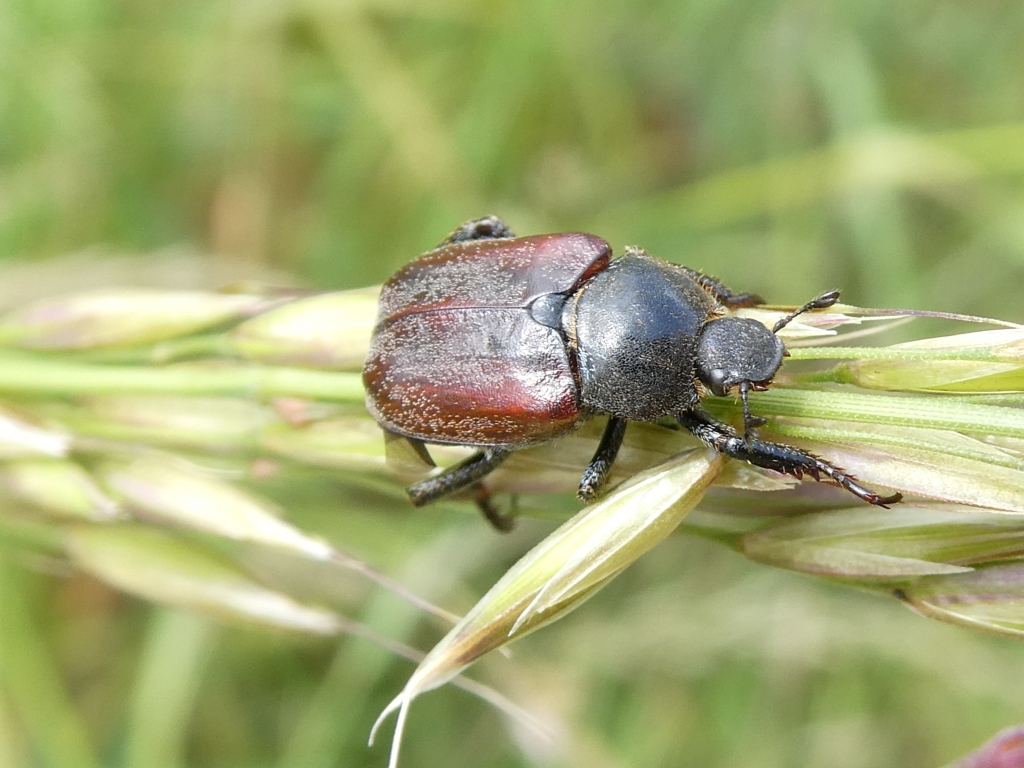Cathy Harris led a walk to the Wellesley Water Meadow SANG on the morning of Wednesday 21 June, starting from Riseley Memorial Hall car park. A SANG is a Suitable Alternative Natural Greenspace which provides a place for dog walking and for the general public to walk. Any development within 5km of the Thames Basin Heaths Special Protection Area must provide a suitable SANG, to take away some of the human and dog pressure on one of our most precious wildlife habitats. The Wellesley Water Meadow SANG was provided as compensation for the Duke’s Meadow housing development in Riseley. At the end of the Memorial Hall car park is a community orchard and flowering there was a clump of Hare’s-foot Clover, with grey-green foliage and cylindrical pink flower heads. Common Bird’s-foot-trefoil was in flower nearby. A Comma butterfly perched on sunny Ivy on the other side of the adjoining hedge. The walk started out eastwards along the Devil’s Highway. This was the Roman road from London to Silchester. It is bordered on each side by a ditch and a line of trees, many of which are old multi-stemmed specimens. Cathy had helped to survey this area for the Wokingham Ancient Tree Inventory and she pointed out several veteran trees. One was a big old oak, with a girth greater than 3m, indicating a probable age of at least 250 years. Another was a big old multi-stemmed Ash. Other trees and shrubs beside the track included Holly, Hawthorn, Gorse, Broom and Bramble. Climbing through the Bramble were Honeysuckle, Bittersweet and Field Rose. Also flowering here were Hedge Woundwort and Foxglove. A Speckled Wood butterfly was seen amongst the dappled sun and shade of the trackway, while Marbled Whites and Meadow Browns flew in an adjoining field. Hemlock Water-dropwort was in flower in the wetter ditches, joined regrettably by a profusion of Himalayan Balsam. Wren and Jay called from nearby. The gravel opposite a track-side cottage was home to a large clump of Scarlet Pimpernel.
The track led to a crossroads and the walk continued along a quiet lane to the right which followed the boundary of Wellington Country Park. An open gateway on the left led into the Wellesley Water Meadow, with a sign at the entrance describing the area. The grass had been recently cut for hay and removed but an unmown strip had been left round the outside, with flowers such as Great Willowherb, Bramble and Creeping Thistle providing nectar for insects. There were many small chafer beetles, thought to be Welsh Chafer Hoplia philanthus, on the vegetation. A mating pair of Large Skipper butterflies perched on a Bramble leaf, while in the grass below were many tiny toadlets. A number of dragonflies and damselflies were seen, including a Banded Demoiselle, a Common Blue Damselfly and a Black-tailed Skimmer. Native trees and bushes had been planted on one side of the field. A Nursery Web Spider was guarding its spiderlings in a web which it had built on a few grass heads. Several Whitethroats were singing from the hedge line. The next section of the walk was over a boardwalk which crossed the wettest part of the field. Plants seen here included Yellow Loosestrife, Greater Bird’s-foot-trefoil, Meadowsweet, Comfrey and Gypsywort. The far side of the field was bounded by the River Whitewater. Blue Water-speedwell and a Little Egret were seen here. The route circled round the field, with a car park for about half a dozen cars at the west side. The insect-spotters at the back found a Mirid bug nymph on a grass head, a Rose Chafer beetle on a thistle flower and a Swollen-thighed Beetle on a Musk Mallow flower. A Grey Heron flew overhead. Leaving the meadow, the return walk followed the lane back northwards for a short distance, then turned along a short track which led back to the Devil’s Highway. Flowering White Bryony, Greater Stitchwort leaves and many more tiny toadlets were seen here. The final section of the walk was back along the Devil’s Highway to Riseley. Most of the group then went to the Bull at Risely for lunch.






Pictures by Rob Stallard and Tom Walker
